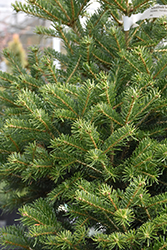It's all about ...
plants

Hupp's Perfect Pillar Nordmann Fir
Abies nordmanniana 'Hupp's Perfect Pillar'
Height: 15 feet
Spread: 4 feet
Sunlight:
![]()
![]()
Hardiness Zone: 4a
Other Names: Caucasian Fir
Description:
An outstanding, slow growing selection that is very upright and narrowly pyramidal, with a very tight, more columnar growth habit; somewhat particular about its growing conditions, not for dry or windy sites, does not tolerate heat
Ornamental Features
Hupp's Perfect Pillar Nordmann Fir is primarily valued in the landscape for its distinctively pyramidal habit of growth. It has dark green evergreen foliage. The needles remain dark green throughout the winter. The smooth gray bark adds an interesting dimension to the landscape.
Landscape Attributes
Hupp's Perfect Pillar Nordmann Fir is a dense evergreen tree with a strong central leader and a distinctive and refined pyramidal form. Its average texture blends into the landscape, but can be balanced by one or two finer or coarser trees or shrubs for an effective composition.
This is a relatively low maintenance tree, and usually looks its best without pruning, although it will tolerate pruning. It has no significant negative characteristics.
Hupp's Perfect Pillar Nordmann Fir is recommended for the following landscape applications;
- Accent
- Vertical Accent
- General Garden Use
Planting & Growing
Hupp's Perfect Pillar Nordmann Fir will grow to be about 15 feet tall at maturity, with a spread of 4 feet. It has a low canopy, and is suitable for planting under power lines. It grows at a slow rate, and under ideal conditions can be expected to live for 90 years or more.
This tree does best in full sun to partial shade. It prefers to grow in moist to wet soil, and will even tolerate some standing water. It is not particular as to soil pH, but grows best in sandy soils. It is quite intolerant of urban pollution, therefore inner city or urban streetside plantings are best avoided, and will benefit from being planted in a relatively sheltered location. Consider applying a thick mulch around the root zone in winter to protect it in exposed locations or colder microclimates. This is a selected variety of a species not originally from North America.
This plant is not reliably hardy in our region, and certain restrictions may apply; contact the store for more information.
